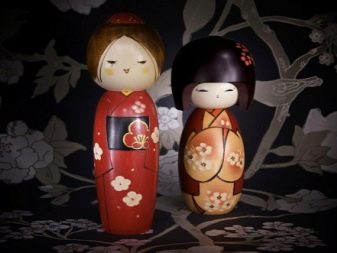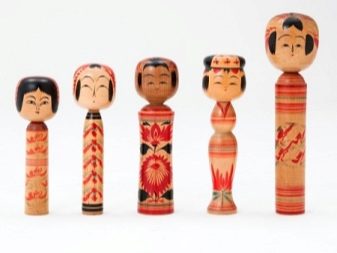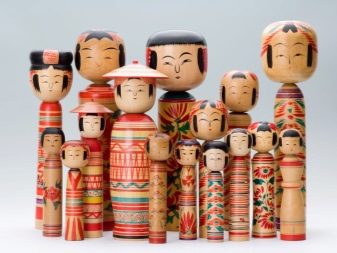Features of Japanese Kokeshi dolls

The traditional direction of making wooden dolls has existed in Japan for several centuries. Kokeshi is a small souvenir and talisman that brings good luck to the owner, prosperity and prosperity. In modern times, in the Land of the Rising Sun, both exclusive collectible dolls and options for the mass consumer are produced.


What it is?
Since ancient times, there are many traditional dolls in Japan, the secrets of their creation were passed on from the master to his students. The most popular are kokeshi. In ancient times, they were given great importance, they acted as a talisman, protection from misfortune, disease.
Kokeshi (kokeshi) are small cylindrical figures made of solid cherry, birch and maple wood. Usually, on a lathe, the body and head are cut out separately, and then connected. The Japanese doll has no limbs. They are painted with leaves, inflorescences and other ornaments. Traditional shades are red, yellow, black. Facial features are applied with several strokes.


Each area had its own secrets of grinding and painting wooden dolls. Centers of handicrafts still exist in Kyoto, Nara, Kagoshima. Modern Japanese souvenirs are created not only from wood, they are made from stone, plastic, cardboard, clay, fabric and thread. The height can be from a few centimeters to a meter. They are painted with a variety of colors and ornaments.
In modern times, it is rather an interior decoration. For example, the Kimmidoll brand has released a whole series of kokeshi dolls, each of which has become the personification of one of the true values in human life.
Souvenirs not only remind of important events in life, but are also a symbol and reminder of the invaluable qualities of a person, such as friendliness, kindness and beauty, courage, loyalty, etc.


Origin story
It is believed that the very first dolls appeared at the end of the 17th century during the heyday of the Edo era, although it is believed that the custom of grinding and giving kokeshi to children has existed for about a thousand years. Production flourished at the end of the Edo period. These dolls are widespread in northeastern Japan, in the town of Tohoku, on the coast of the island of Honshu - there are hot healing springs here, people came here for rest and treatment from all over the country. There is a version that the pupae, uncoated with paint, were used as a massager when taking water procedures.
The Japanese have long developed a special etiquette when presenting gifts, it clearly states what to give, when, how and on what occasion. There is a special kind of present - in memory of important events in life. Such souvenirs began to be offered to those who visited medical resorts. Soon, wooden products became the hallmark of the area. Visitors were in a hurry to buy kokeshi and take them as a gift to their families.


There is a legend that the gods will give a bountiful harvest if they see that the kids are playing with dolls. The ubiquity of kokeshi can also be explained by the fact that these were very inexpensive souvenirs. According to legends, they keep their homes from fires and do not let evil spirits in. Souvenirs are made from high-quality wood, but before the tree is left to lie in the open air for about 5 years. The color of the material often gives the toy different shades: from Japanese maple - light toys, and from cherry - dark ones.
A traditional wooden figurine was made as follows: the details were turned on a lathe and polished smoothly, then they connected the head to the body with a special rod. Each character was painted individually.
According to the rules established for a long time, kokeshi look like girls in national dress - kimono. The shape and expression of faces are different - there are serious ones, and there are smiling ones.


Views
There are canonical and modern variations of wood figurines. The main principle - minimalism and beauty - remains, probably, that is why the production of kokeshi is considered a national art form in modern Japan as well.
Classic
Traditional toys have very simple shapes and designs. The very first items were made without painting; they are characterized by a thin body and a round head. The manner of manufacturing in each locality was unique, the product from one area is not similar to others. Each of the eleven regions of Japan has its own unique painting technique.


Art critics distinguish 11 types at the place of creation.
- Tsukiyu - original dolls appeared in Fukushima. The long slender neck is inserted into the long body. On the crown there is a double ring in a red shade with a special pattern. The kimono is decorated with a ring pattern.
- Togatta - Made in the Miyagi area, they have a straight and thin body. Very narrow eyes are drawn on the face, red lines diverge from the crown of the head, which pass through the forehead and down the cheeks. Chrysanthemums and plum blossoms are depicted on the clothes. Some examples have hairstyles with shoulder-length hair, often products are painted in different shades and patterns.
- Yajiro - appeared in the city of Sirokishi, the main difference is the head-stubs connected to the body. The crown is decorated with a pattern resembling a beret. Quite voluminous in format, painted with flowers and leaves.
- Naruko - began to do for the first time in the town of Naruko. It is distinguished by a long neck, the face is framed by black strands. The most important difference: the head of the figure rotates, while a sound is heard that resembles crying. She is also called the "crying doll".
- Sakunami - produced in the region of the same name. It has a large stub head on a slender body.On the sides, below and above, a bright ring ornament is applied in combination with a pattern of chrysanthemums, the hair is drawn with bangs, and there is always a small strand on the crown.
- Yamagata - developed in the Sakunami region. This trend is distinguished by thin composite figures. There are patterns on the crown in the form of rings, on the body there are images of cherry and plum inflorescences, as well as chrysanthemum buds.
- Kajiyama - done in the town of Akita. Was carved from a whole piece of wood. Long bangs are drawn on the forehead, the body is decorated with an apron with chrysanthemum buds.
- Nanbu - appeared in the regional center of Iwate. Traditionally, toys with a movable head were produced. Made specifically for babies who have teething, usually made without painting.
- Tsugaru - produced in Ovani. They made solid figures, but made them very diverse: some had a wasp waist, others had broad shoulders. Often the faces of the dolls are framed with black hair, the patterns on the body can be very different.
- Dzao-takayu - are made in Yamagata Prefecture. They are a variation of the Togatta, but have round and firm bodies. The face from the sides is drawn in red, often a square is drawn with black paints. Kimonos are painted with chrysanthemums and cherry blossoms.
- Hijiori - created from a combination of types Togatta and Naruko, produced in the cities of Yamagata and Sendai. The hair is dyed black with the addition of red patterns. The body is wide enough with powerful shoulders, painted with chrysanthemum flowers and bamboo shoots.






The most widely known varieties are Naruko and Togatta. Traditional varieties differ in the shape of the body, the size of the head, the features of the application of ornaments and facial features. Eyes are also different in shape and size: there are more rounded or elongated almond-shaped ones, there are differences in the colors of the kimono, as well as in the nature of the placement of buds and stripes on it. Much depends on the manufacturing technology: in Sakunami, for example, some products are covered with embossed carvings, while others are only painted. In Yaziro, the workpiece is painted on a lathe, and some of the lines are applied while the workpiece is rotated, so a ring painting is obtained.
The choice of colors often depends on the master, but more often it is a combination of black, red and yellow. Modern toys are painted more colorfully than old ones; they are often purchased by foreign tourists. Classic antique dolls are antique and can go up to several thousand dollars.



Modern
In addition to classic dolls in modern Japan, they also produce designer dolls. Works of authorship is not limited by anything other than imagination. Products differ in variety, often the hairstyle is not painted, but cut out of wood, ornaments are also distinguished by originality. In many cases, the material for manufacturing is not only wood, but also porcelain, fabric, plastic. Such toys depict not only beautiful Japanese women in kimonos painted with flowers, but also samurai and fantastic creatures from Japanese traditions and legends. Often in the guise of modern varieties, you can recognize the characters of popular films: Luke Skywalker, Yoda, Obi-Wan Kenobi - the heroes of the Star Wars film cycle, Mickey Mouse and his girlfriend, Mini-cartoons invented by Walt Disney.
One type of Shingata kokeshi is designer and creatively designed dolls. Often, the performance is allowed to deviate from the canons of making wooden toys. Contemporary Japanese artists continue to come up with new shapes and designs for dolls. When creating them, craftsmen can use unusual combinations of shades and different techniques - engraving, glaze, etc.
Now kokeshi is one of the most popular souvenirs in Japan.











